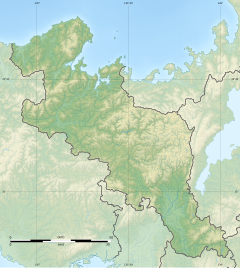Yamaga Domain (山家藩, Yamaga-han) was a feudal domain under the Tokugawa shogunate of Edo period Japan, located in Tanba Province in what is now the west-central portion of modern-day Kyoto Prefecture. It was centered around Yamaga jin'ya in what is now the Hirose neighborhood of the city of Ayabe, Kyoto.[1][2][3]
| Yamaga Domain 山家藩 | |
|---|---|
| under Tokugawa shogunate Japan | |
| 1582–1871 | |
| Capital | Yamaga jin'ya |
| Area | |
| • Coordinates | 35°17′48.5″N 135°7′46.8″E / 35.296806°N 135.129667°E |
| • Type | Daimyō |
| Historical era | Edo period |
• Established | 1582 |
• Disestablished | 1871 |
| Today part of | part of Kyoto Prefecture |

History
editThe Tani clan was originally from Mino Province and were early retainers of Oda Nobunaga. Tani Moritomo participated in all of the campaigns of Toyotomi Hideyoshi and was rewarded with a 16,000 koku domain in Tanba Province in 1582. During the Battle of Sekigahara, he served in the Western Army, and was ordered by Ishida Mitsunari to attack Tanabe Castle, whose lord, Hosokawa Fujitaka was a personal friend. Tani made a great show of attacking the castle, but famously, all of his soldiers and cannons were firing blank rounds at the castle. For this reason, he received no punishment from the victorious Tokugawa Ieyasu and was confirmed as daimyō of his existing holdings under the Tokugawa shogunate. He went on to serve the Tokugawa at the Siege of Osaka. The clan would continue to rule Yamaga for 13 generations until the Meiji restoration. However, Tani Moritomo's son, Tani Morimasa, distributed 6000 koku of his holdings to his younger brother and two cousins, reducing the domain to the bare minimum requirement to maintain its status. Since the domain was located in a mountainous area with little land suitable for rice cultivation, the domain's finances were supported by forestry and production of washi paper. During the Bakumatsu period, the domain was one of the first to support the new Meiji government. In 1871, with the abolition of the han system, Yamaga briefly became "Yamaga Prefecture", which was merged with Kyoto Prefecture a few months later. The final daimyō, Tani Morishige, became a viscount (shishaku) in the kazoku peerage in 1884.
Holdings at the end of the Edo period
editAs with most domains in the han system, Yamaga Domain consisted of several discontinuous territories calculated to provide the assigned kokudaka, based on periodic cadastral surveys and projected agricultural yields.[4][5]
- Tanba Province
- 44 villages in Ikaruga District
List of daimyō
edit# Name Tenure Courtesy title Court Rank kokudaka Tani clan, 1582-1871 (tozama) 1 Tani Moritomo (谷衛友) 1582 – 1627 Dewa-no-kami (出羽守) Junior 5th Rank, Lower Grade (従五位下) 16,000 koku 2 Tani Morimasa (谷衛政) 1628 – 1662 Daigaku-no-kami (大学頭) Junior 5th Rank, Lower Grade (従五位下) 16,000 -> 10,000 koku 3 Tani Morihiro (谷衛広) 1663 – 1689 Dewa-no-kami (出羽守) Junior 5th Rank, Lower Grade (従五位下) 10,000 koku 4 Tani Moriyori (谷衛憑) 1689 – 1717 Harima-no-kami (播磨守) Junior 5th Rank, Lower Grade (従五位下) 10,000 koku 5 Tani Morimichi (谷衛衝) 1717 – 1762 Dewa-no-kami 出羽守) Junior 5th Rank, Lower Grade (従五位下) 10,000 koku 6 Tani Morimasa (谷衛将1) 1762 – 1764 Daigaku-no-kami (大学頭) Junior 5th Rank, Lower Grade (従五位下) 10,000 koku 7 Tani Morihide (谷衛秀) 1764 – 1780 Harima-no-kami (播磨守) Junior 5th Rank, Lower Grade (従五位下) 10,000 koku 8 Tani Morikazu (谷衛量) 1780 – 1801 Harima-no-kami (播磨守) Junior 5th Rank, Lower Grade (従五位下) 10,000 koku 9 Tani Moritaka (谷衛萬) 1801 – 1816 Daigaku-no-kami (大学頭) Junior 5th Rank, Lower Grade (従五位下) 10,000 koku 10 Tani Morimitsu (谷衛弥) 1816 – 1820 Ukyo-no-suke (右京亮) Junior 5th Rank, Lower Grade (従五位下) 10,000 koku 11 Tani Moriyasui (谷衛昉) 1820 – 1845 Dewa-no-kami 出羽守) Junior 5th Rank, Lower Grade (従五位下) 10,000 koku 12 Tani Morinori (谷衛弼) 1845 – 1856 Harima-no-kami 播磨守) Junior 5th Rank, Lower Grade (従五位下) 10,000 koku 13 Tani Morishige (谷衛滋) 1856 – 1871 Daizen-no-suke (大膳亮) Junior 5th Rank, Lower Grade (従五位下) 10,000 koku
See also
editFurther reading
edit- Bolitho, Harold. (1974). Treasures Among Men: The Fudai Daimyo in Tokugawa Japan. New Haven: Yale University Press. ISBN 978-0-300-01655-0; OCLC 185685588
- Genealogy of the Aoyama clan (in Japanese)
- Japan Gazette (1912). Peerage of Japan. n.p.
- Papinot, Edmond (1972). Historical and Geographical Dictionary of Japan. Vermont: Tuttle.
- Tsukahira, Toshio George (1966). Feudal Control in Tokugawa Japan: The Sankin Kōtai System. Boston: Harvard University Press.
References
edit- ^ Nakayama, Yoshiaki (2015). 江戸三百藩大全 全藩藩主変遷表付. Kosaido Publishing. ISBN 978-4331802946.(in Japanese)
- ^ Nigi, Kenichi (2004). 藩と城下町の事典―国別. Tokyodo Printing. ISBN 978-4490106510.
- ^ Papinot, E (1910). Historical and Geographic Dictionary of Japan. Tuttle (reprint) 1972.
- ^ Mass, Jeffrey P. and William B. Hauser. (1987). The Bakufu in Japanese History, p. 150.
- ^ Elison, George and Bardwell L. Smith (1987). Warlords, Artists, & Commoners: Japan in the Sixteenth Century, p. 18.

